Years of service 1869–1919 Name August Mackensen | Rank Generalfeldmarschall Service/branch German Army | |
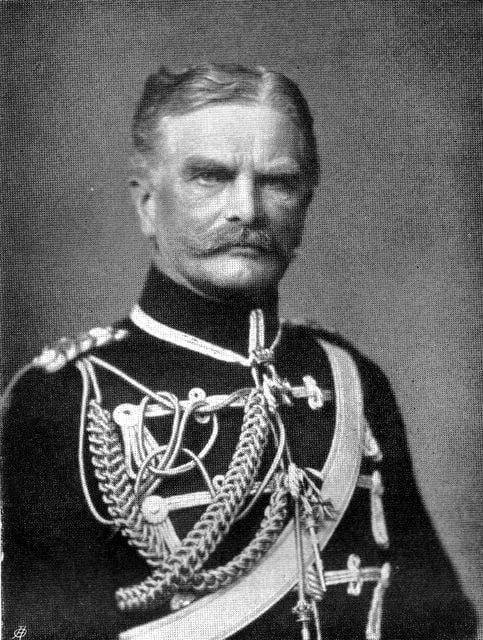 | ||
Birth name Anton Ludwig August von Mackensen Similar People Erich von Falkenhayn, Paul von Hindenburg, Erich Ludendorff, Alexandru Averescu, Franz Conrad von Hotz | ||
Anton Ludwig August von Mackensen (6 December 1849 – 8 November 1945), born August Mackensen, was a German soldier and field marshal. He commanded with success during the First World War and became one of the German Empire's most prominent military leaders. After the Armistice, Mackensen was interned for a year. He retired from the army in 1920 and was made a Prussian state councillor in 1933 by Hermann Goring. During the Nazi era, Mackensen remained a committed monarchist and sometimes appeared at official functions in his First World War uniform. He was suspected of disloyalty to the Third Reich, although nothing was proven against him.
Contents
- Early years
- Eastern Front
- Serbian campaign
- Romanian campaign
- Post war career
- Family
- Citation
- Honours
- References

Early years
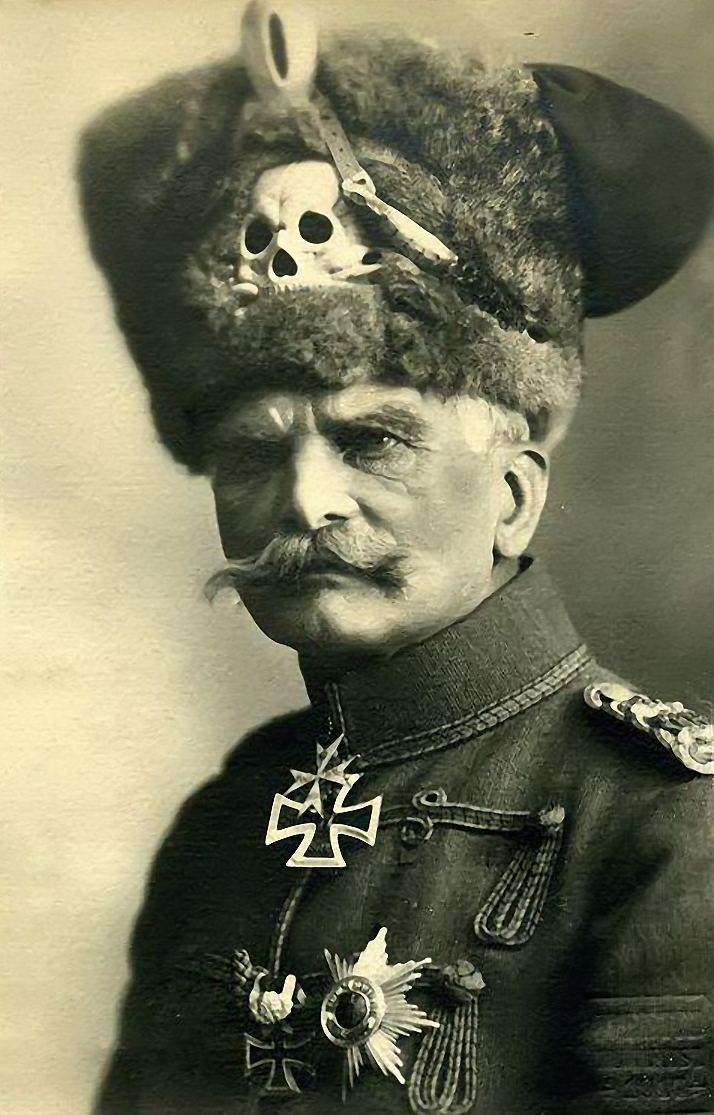
Mackensen was born in Haus Leipnitz, near the village of Dahlenberg (today part of Trossin) in the Prussian Province of Saxony, to Louis and Marie Louise Mackensen. His father, an administrator of agricultural enterprises, sent him to a Realgymnasium in Halle in 1865, seemingly in the hope that Mackensen would follow him in his profession.
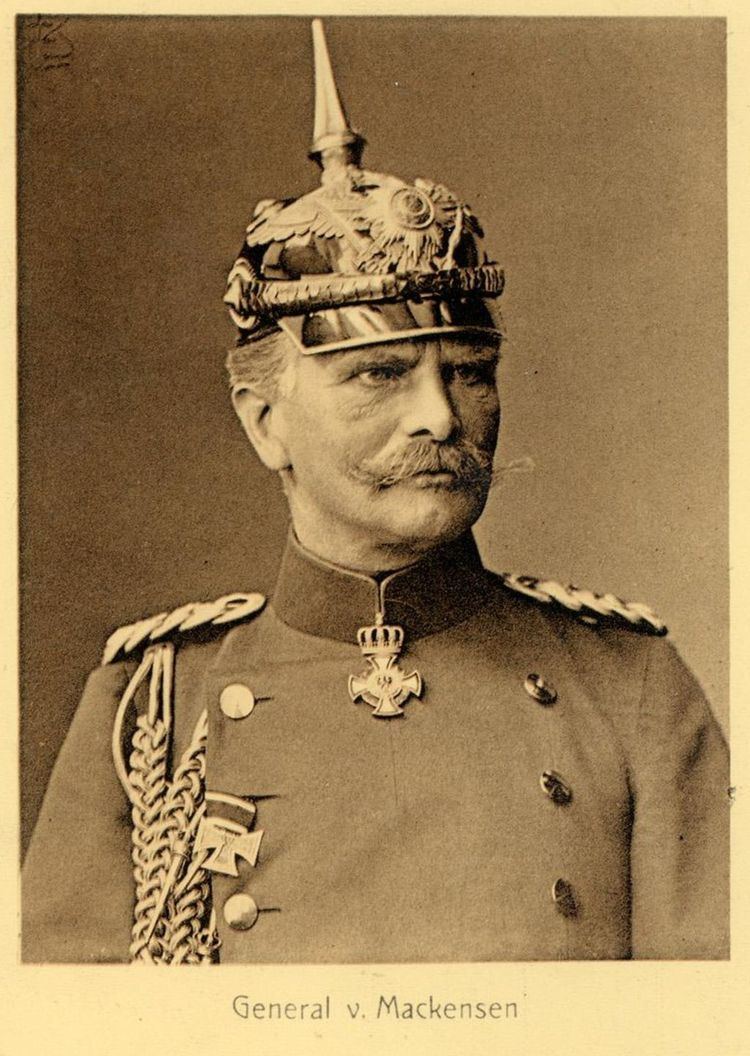
Mackensen began his military service in 1869 as a volunteer with the Prussian 2nd Life Hussars Regiment (Leib-Husaren-Regiment Nr. 2). During the Franco-Prussian War he was promoted to second lieutenant and recommended for the Iron Cross, Second Class. He left the service and studied at Halle University, but returned to the German Army in 1873, with his old regiment. Regarded as among the finest horsemen in the Empire, he was detached from normal duties to serve as a tutor in military history to the future Kaiser Wilhelm II, who would later send his own son to serve in Mackensen's regiment. Close relations between the Emperor and Mackensen would continue for many years. In 1891, he joined the General Staff in Berlin, where he was heavily influenced by the new chief, Alfred von Schlieffen.

From 17 June 1893 to 27 January 1898, Mackensen commanded the 1st Life Hussars Regiment (Leib-Husaren-Regiment Nr. 1), to which he became a la suite when he left its command, and whose uniform he often wore as a general. He was ennobled on 27 January 1899, becoming August von Mackensen. From 1901 to 1903, he commanded the Life Hussar Brigade (Leib-Husaren-Brigade), and from 1903 to 1908 commanded the 36th Division in Danzig. When Schlieffen retired in 1906, Mackensen was regarded by some as a possible successor, but the job went to Helmuth von Moltke the Younger. In 1908, Mackensen was given command of the XVII Army Corps and commanded this corps until shortly after the beginning of the First World War.
Eastern Front
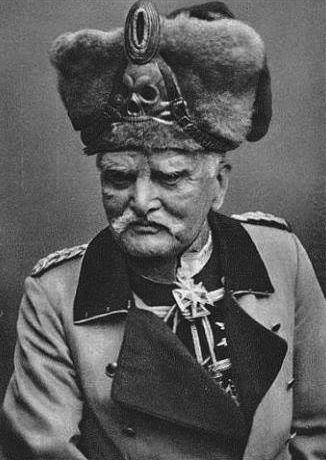
Already aged sixty-five at the outbreak of War in 1914, Mackensen remained in command of XVII Army Corps as part of the German Eighth Army, first under General Maximilian von Prittwitz and later under General Paul von Hindenburg. Mackensen had his corps moving out on a twenty-five kilometer march to the Rominte River within fifty minutes of receiving its orders on the afternoon of August 19th, 1914 as the Imperial Russian Army invaded East Prussia. Soon after, Mackensen's corps fought in the battles of Gumbinnen and Tannenberg.
On 2 November 1914 Mackensen took command of the Ninth Army from Hindenburg, who had been named Supreme Commander East (Oberbefehlshaber Ost). On 27 November 1914 Mackensen was awarded the Pour le Merite, Prussia's highest military order, for actions around Lodz and Warsaw.
He commanded the Ninth Army until April 1915, when he took command of the Eleventh Army and Army Group Mackensen (Heeresgruppe Mackensen), seeing action in Galicia and assisting in the capture of Przemysl and Lemberg.
He was awarded oak leaves to the Pour le Merite on 3 June 1915 and promoted to field marshal on 22 June. After this campaign, he was awarded the Order of the Black Eagle, Prussia's highest-ranking order of knighthood. During this period, he also received numerous honours from other German states and Germany's allies, including the Grand Cross of the Military Order of Max Joseph, the highest military honour of the Kingdom of Bavaria, on 4 June 1915.
Serbian campaign

In October 1915, Mackensen, in command of the newly formed Army Group Mackensen (Heeresgruppe Mackensen, which included the German 11th Army, Austro-Hungarian 3rd Army, and Bulgarian 1st Army), led a renewed German-Austro-Hungarian-Bulgarian campaign against Serbia. The campaign finally crushed effective military resistance in Serbia but failed to destroy the Serbian army, which, though cut in half, managed to withdraw to Entente-held ports in Albania and, after recuperation and rearmament by the French and the Italians, reentered fighting on the Macedonian front. During the fight for Belgrade in early October 1915, the troops of the Central Powers encountered a very stiff resistance, so Mackensen erected a monument to the Serbian soldiers who died defending Belgrade, saying, -HIER RUHEN SERBISCHE HELDEN- - "Here rest Serbian heroes", both in German and Serbian.
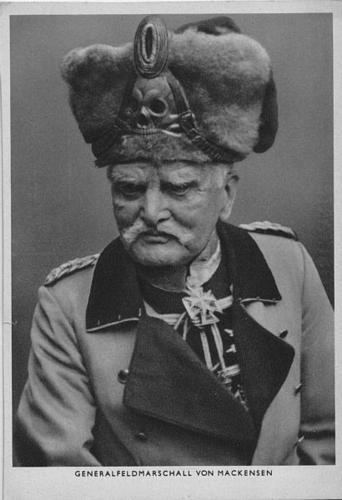
Mackensen is a figure in Serbian historiography and is greatly respected, the only enemy soldier and military leader to be so treated. He is always mentioned as an opponent who respected the Serbian soldiers and people.
Romanian campaign
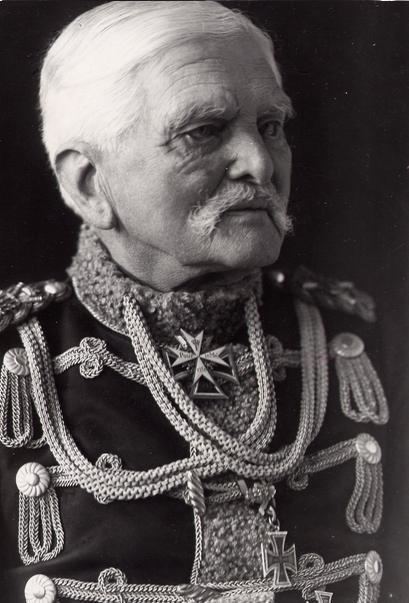
He followed this up in 1916 with a successful campaign against Romania (under the overall command of General Erich von Falkenhayn). He was in command of a multi-national army of Bulgarians, Ottoman Turks, and Germans. Despite this, his offensives were very successful, breaking every army that faced his own. On 9 January 1917, Mackensen was awarded the Grand Cross of the Iron Cross, becoming one of only five recipients of this honour in the First World War.
From 1917 on, Mackensen was the military governor of the parts of Romania (mainly Wallachia) controlled by the Central Powers. His last campaign was an attempt to destroy the Romanian Army, which had been reorganised after the Kerensky Offensive, and occupy the rest of the country (the north-eastern part). But the attempt failed at the Battle of Marasesti, both sides taking heavy losses, but with the Romanian army victorious.
By December 1917, the Russian Army had collapsed and Romania was forced to sign the Armistice of Focsani, followed by the humiliating Treaty of Bucharest (1918). Mackensen remained in Romania until the end of the war as military governor and de facto ruler. Because Mackensen didn't participate in the last battles of World War I, he claimed during the Nazi-era that he had never been defeated in battle.
At the end of the war, he was captured by General Louis Franchet d'Esperey's Allied army in Hungary (namely by the Serbian units) and held as a military prisoner in Futog, until November 1919.
Post-war career
In 1920, Mackensen retired from the army. Although standing in opposition to the newly established republican system, he avoided public campaigns. Around 1924 he changed his mind and began to use his image as war hero to support conservative monarchist groups. He routinely appeared in his old Life Hussars uniform and became very active in pro-military conservative organisations, particularly the Stahlhelm and the Schlieffen Society.
During the German presidential election of 1932, Mackensen supported Hindenburg against Hitler, but after Hitler gained power in 1933 Mackensen became a visible, if only symbolic, supporter of the Nazi regime.
One of his ceremonial visits bought him to Passau, where he received a hero's welcome.
Mackensen's high-profile public profile, in his distinctive black Life Hussars uniform, was recognized by the Hausser-Elastolin company, which produced a 7-cm figure of him in its line of Elastolin composition soldiers. Mackensen's fame and familiar uniform gave rise to two separate Third Reich units adopting black dress with Totenkopf badges: the Panzerwaffe, which claimed the tradition of the Imperial cavalry; and Hitler's "Life Guards," the SS.
Although Mackensen appeared in his black uniform at public events organized by the German government or the Nazi Party, he objected to the killing of Generals Ferdinand von Bredow and Kurt von Schleicher during The Night of the Long Knives purge of July 1934, and to the atrocities committed during the fighting in Poland in September 1939. By the early 1940s, Hitler and Joseph Goebbels suspected Mackensen of disloyalty, but could do nothing. Mackensen remained a committed monarchist and in 1941 appeared in full imperial uniform at Kaiser Wilhelm's funeral at Doorn, in the Netherlands.
According to a radio news report dated 15 April 1945, filed by CBS News correspondent Larry LeSueur for World News Today, Mackensen was briefly captured by the British Second Army at his home during the closing weeks of the Second World War. Upon the arrival of the British, rather than making an expected war-like statement, the old soldier merely made the request that newly freed foreign workers should be "kept from stealing his chickens".
Mackensen died on 8 November 1945 at the age of 95, his life having spanned the Kingdom of Prussia, the North German Confederation, the German Empire, the Weimar Republic, Nazi Germany, and the post-war Allied occupation of Germany.
Family
In November 1879, Mackensen married Dorothea von Horn (1854–1905), and they had five children:
In 1908, after the death of his first wife, Mackensen married Leonie von der Osten (1878–1963).
Citation
On 4 February 1940, Mackensen wrote to Field Marshal Walther von Brauchitsch: "As a man becomes older, he has to watch carefully that age has not reduced his creativity. After reaching the age of 90, I have decided not to involve myself any longer with matters that are not concerned with my private life. However, I am still the most senior German officer. Many turn to me, sometimes with wishes, but more often with their concerns. During these weeks our concern is with the spirit of our unique and successful Army. The concern results from the crimes committed in Poland, looting and murder that take place before the eyes of our troops, who appear unable to put an end to them. An apparent indifference has serious consequences for the morale of our soldiers and it is damaging to the esteem of our Army and our whole nation. I am sure that you are aware of these events and that you certainly condemn them. These lines intend to convey my daily growing concern at the reports that constantly reach me, and I have to ask you to take up this matter with the highest authority. The messages I receive are so numerous, many come from high ranking persons and from witnesses. As the most senior officer I cannot keep them to myself. In transmitting them to you, I fulfil my duty to the Army. The honour of the Army and the esteem in which it is held must not be jeopardised by the actions of hired subhumans and criminals. Sieg heil."
Honours
The University of Halle-Wittenberg appointed him to Honorary Doctor of Political Sciences and the Gdansk University of Technology granted him the title Doktor-Ingenieur.
Mackensen-class battlecruiser, named after Mackensen, was the last class of battlecruisers to be built by Germany in the First World War, the lead ship, SMS Mackensen, was launched on 21 April 1917.
Mackensen was an Honorary Citizen of many cities, such as Danzig, Heilsberg, Buetow, and Tarnovo. In 1915, the newly built rural village of Mackensen in Pomerania was named after him. In various cities, streets were named after him. In 1998 the Mackensenstrasse in the Schoneberg district of Berlin was renamed Else Lasker-Schuler-road, based on an erroneous claim that Mackensen was one of the "pioneers of National Socialism".
